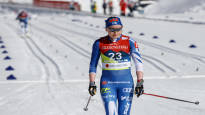Planica’s World Cup skiing has again followed the familiar pattern. Ivo and Kerttu Niskanen mixed Krista Pärmäkoski have been Finland’s success teeth. The result has been one surprise medal from the men’s WC relay before Iivo Niskanen’s main trip. Iivo Niskanen played a significant role in that as well.
Finnish female skiers were left without a single World Cup medal. Kerttu in Niskase was a competition of adversity. Before the combined race, Niskanen injured his leg during training. On Saturday, in the traditional 30 kilometers, Niskasen did not have the skis required for a medal.
Krista Pärmäkoski on the other hand, was no longer in the mood seen at the turn of the year after the stomach bug he got at the Tour de Ski.
– The whole shows that the situation of Finnish cross-country skiing is not as good as it should be. Success is measured by medals. Saturday said that Kerttu Niskanen operates at his own good basic level. Others underperformed compared to their level, Urheilu’s expert Kalle Lassila states.
Lassila spoke before the World Championships that Planica’s tough courses and conditions should suit the Finns, and especially the Niskanen siblings, well.
– Not favored but enough, Lassila admitted that she was wrong.
Lassila admits that the success advocated by two Niskanens and one Pärmäkoski is not sustainable development. All three athletes are already over 30 years old, so they no longer have any young promises.
– The Finnish coaching system has been modified. There is quite a lot to do. Does it produce something that a large country should? Lassila asks.
– Now it looks like it won’t. It’s not right that our tip is so narrow. In practice, it depends on the siblings what the situation is like in Finnish cross-country skiing.
The experts make the sports people concrete
From Finland’s point of view, the medal battle at the World Championships in Planica is not a flattering thing to watch, either. Norway leads with 14 medals. Led by its top women, Sweden has won historic competitions with 11 medals and 4 gold medals. Finland has one World Cup silver, like Italy.
Urheilu’s experts Ville Nousiainen makes the athletes concrete when trying to develop better skiers in Finland.
– It would be possible to assess the strengths and weaknesses of different athletes. Let’s start developing them right away in the spring. If we think about and wait for autumn, there is very little time to do during the training season. It should also be done during the competition season. If the development periods are ended in September-October, there is only four months a year to train. It is mercilessly too little, Nousiainen throws an example.
Kalle Lassila also needs concrete.
– We have a lot of coaches in Finland. Personal coaches, academy coaches and federation coaches. But who leads the coaching culture and directs the discussion culture? Lassila asks.
According to Lassila, in the Finnish coaching discussion, there is a lot of movement at the headline level, and talk about sustainability, for example, is raised.
– I am asking for a precise analysis of the sport and clarification of the rules of the game. Concrete measures can be taken when the basics are known. Then we also know exactly what has been done. Then the changes can be measured in order to see their functionality, says Lassila.
Finns’ skills on wallpaper
The Finns’ ability to adapt to different conditions has also come to the fore at the World Championships in Planica. The games are remembered for the many falls of Finns on the ski slopes. The Finns are also known to be a temporary departure nation, and not so much a joint departure nation.
– It is typical for us for many national team-level athletes that, for example, on a roller ski mat, we ski at a steady angle and uphill. The work then works technically, Lassila illustrates.
In changing conditions, it goes badly.
– When there is soft, icy, bendy or terrain that requires varying techniques, the Finns want to be left behind, Lassila states.
In this sense, Ville Nousiainen emphasizes versatile exercise for young Finnish skiers.
– Ball games, cross-country races and everything like that. It helps that you can learn something new at the age of 25–30, Nousiainen reminds.
Matintalo, considered a medal candidate: “We practiced at risk”
Of course, the balance of one World Cup medal before Iivo Niskanen’s main trip is not a terribly big surprise if we think coldly realistically.
Even before the games, it could be concluded from the statistics that the historical games with zero World Cup medals are possible.
After the Olympics that went well earlier, Finland has a poor balance in the World Championships. This was the case, for example, in Seefeld 2019 and Falun 2015. In 2019, the only Finnish medalist was Iivo Niskanen on the normal distance of traditional skiing.
There were three fourth places in Seefeld. In Falun, the only medal came from the women’s relay. There were also two fourth places. In Planica, one of the fourth places in the women’s relay has come.
Over the course of the season Johanna from Matintalo was also talked about as a medal candidate for the World Championships in Planica. He reached the podium at the beginning of December at the Beitostölen World Cup.
The best results from the Finnish World Cup team were also seen that weekend. Last year’s Olympic sprint Nelone and pair sprint silver medalist Joni Mäki was fifth in Beitostölen.
Matintalo was in trouble in Planica already after the WC sprint. At the time, it was suspected that the dirty load played its part.
– Surely there was even a little too much practice. I had tough goals for these games. I knew that you won’t get top rankings by verifying. We practiced even at risk. It even went a little overboard, Matintalo said.
